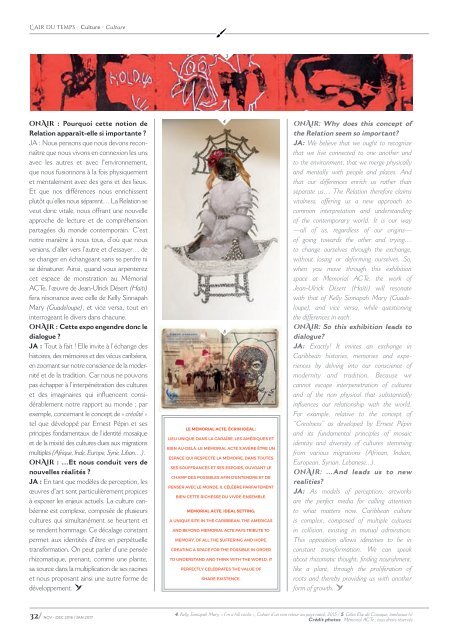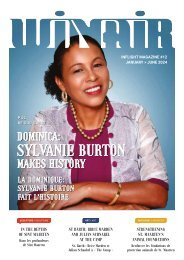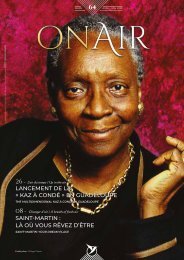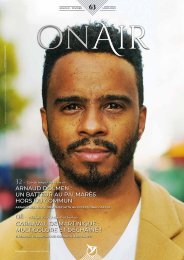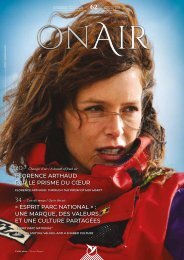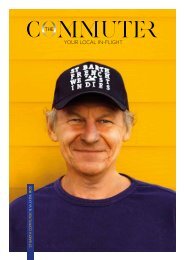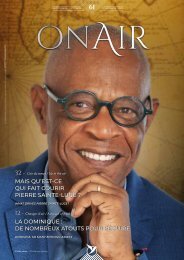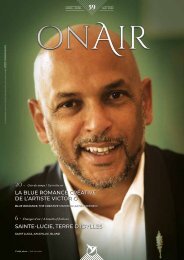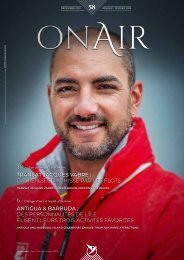ON AIR MAGAZINE #35
You also want an ePaper? Increase the reach of your titles
YUMPU automatically turns print PDFs into web optimized ePapers that Google loves.
L’ air du temps / Culture • Culture<br />
3<br />
onAir : Pourquoi cette notion de<br />
Relation apparaît-elle si importante ?<br />
JA : Nous pensons que nous devons reconnaître<br />
que nous vivons en connexion les uns<br />
avec les autres et avec l'environnement,<br />
que nous fusionnons à la fois physiquement<br />
et mentalement avec des gens et des lieux.<br />
Et que nos différences nous enrichissent<br />
plutôt qu’elles nous séparent… La Relation se<br />
veut donc vitale, nous offrant une nouvelle<br />
approche de lecture et de compréhension<br />
partagées du monde contemporain. C’est<br />
notre manière à nous tous, d’où que nous<br />
venions, d’aller vers l’autre et d’essayer… de<br />
se changer en échangeant sans se perdre ni<br />
se dénaturer. Ainsi, quand vous arpenterez<br />
cet espace de monstration au Mémorial<br />
ACTe, l’œuvre de Jean-Ulrick Désert (Haïti)<br />
fera résonance avec celle de Kelly Sinnapah<br />
Mary (Guadeloupe), et vice versa, tout en<br />
interrogeant le divers dans chacune.<br />
onAir : Cette expo engendre donc le<br />
dialogue ?<br />
JA : Tout à fait ! Elle invite à l’échange des<br />
histoires, des mémoires et des vécus caribéens,<br />
en zoomant sur notre conscience de la modernité<br />
et de la tradition. Car nous ne pouvons<br />
pas échapper à l’interpénétration des cultures<br />
et des imaginaires qui influencent considérablement<br />
notre rapport au monde ; par<br />
exemple, concernant le concept de « créolité »<br />
tel que développé par Ernest Pépin et ses<br />
principes fondamentaux de l’identité mosaïque<br />
et de la mixité des cultures dues aux migrations<br />
multiples (Afrique, Inde, Europe, Syrie, Liban…).<br />
onAir : …Et nous conduit vers de<br />
nouvelles réalités ?<br />
JA : En tant que modèles de perception, les<br />
œuvres d'art sont particulièrement propices<br />
à exposer les enjeux actuels. La culture caribéenne<br />
est complexe, composée de plusieurs<br />
cultures qui simultanément se heurtent et<br />
se rendent hommage. Ce décalage constant<br />
permet aux identités d'être en perpétuelle<br />
transformation. On peut parler d’une pensée<br />
rhizomatique, prenant, comme une plante,<br />
sa source dans la multiplication de ses racines<br />
et nous proposant ainsi une autre forme de<br />
développement.<br />
4<br />
5<br />
LE MÉMORIAL ACTE, ÉCRIN IDÉAL :<br />
LIEU UNIQUE DANS LA CARAÏBE, LES AMÉRIQUES ET<br />
BIEN AU-DELÀ, LE MÉMORIAL ACTE S’AVÈRE ÊTRE UN<br />
ESPACE QUI RESPECTE LA MÉMOIRE, DANS TOUTES<br />
SES SOUFFRANCES ET SES ESPOIRS, OUVRANT LE<br />
CHAMP DES POSSIBLES AFIN D’ENTENDRE ET DE<br />
PENSER AVEC LE M<strong>ON</strong>DE. IL CÉLÈBRE PARFAITEMENT<br />
BIEN CETTE RICHESSE DU VIVRE-ENSEMBLE.<br />
MEMORIAL ACTE, IDEAL SETTING:<br />
A UNIQUE SITE IN THE CARIBBEAN, THE AMERICAS<br />
AND BEY<strong>ON</strong>D, MEMORIAL ACTE PAYS TRIBUTE TO<br />
MEMORY, OF ALL THE SUFFERING AND HOPE,<br />
CREATING A SPACE FOR THE POSSIBLE IN ORDER<br />
TO UNDERSTAND AND THINK WITH THE WORLD. IT<br />
PERFECTLY CELEBRATES THE VALUE OF<br />
SHARE EXISTENCE.<br />
onAir: Why does this concept of<br />
the Relation seem so important?<br />
JA: We believe that we ought to recognize<br />
that we live connected to one another and<br />
to the environment, that we merge physically<br />
and mentally with people and places. And<br />
that our differences enrich us rather than<br />
separate us… The Relation therefore claims<br />
vitalness, offering us a new approach to<br />
common interpretation and understanding<br />
of the contemporary world. It is our way<br />
—all of us, regardless of our origins—<br />
of going towards the other and trying…<br />
to change ourselves through the exchange,<br />
without losing or deforming ourselves. So,<br />
when you move through this exhibition<br />
space at Memorial ACTe, the work of<br />
Jean-Ulrick Désert (Haïti) will resonate<br />
with that of Kelly Sinnapah Mary (Guadeloupe),<br />
and vice versa, while questioning<br />
the differences in each.<br />
onAir: So this exhibition leads to<br />
dialogue?<br />
JA: Exactly! It invites an exchange in<br />
Caribbean histories, memories and experiences<br />
by delving into our conscience of<br />
modernity and tradition. Because we<br />
cannot escape interpenetration of cultures<br />
and of the non physical that substantially<br />
influences our relationship with the world.<br />
For example, relative to the concept of<br />
“Creolness” as developed by Ernest Pépin<br />
and its fundamental principles of mosaic<br />
identity and diversity of cultures stemming<br />
from various migrations (African, Indian,<br />
European, Syrian, Lebanese...).<br />
onAir: …And leads us to new<br />
realities?<br />
JA: As models of perception, artworks<br />
are the perfect media for calling attention<br />
to what matters now. Caribbean culture<br />
is complex, composed of multiple cultures<br />
in collision, existing in mutual admiration.<br />
This opposition allows identities to be in<br />
constant transformation. We can speak<br />
about rhizomatic thought, finding nourishment,<br />
like a plant, through the proliferation of<br />
roots and thereby providing us with another<br />
form of growth.<br />
32<br />
NOV - DEC 2016 / JAN 2017<br />
4. Kelly Sinnapah Mary, « I’m a hill coolie », Cahier d’un non retour au pays natal, 2015 / 5. Gilles Elie dit Cosaque, lambeaux h1<br />
Crédit photos : Mémorial ACTe ; tous droits réservés


